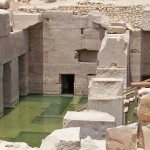Edition - July, 2011

Notes on the Osireion at Abydos
The Osireion was first excavated by Sir William Flinders Petrie, Margaret Murray and Petrie’s wife in the early 1900s. They found the tunnel and excavated towards what they called the “hypogeum.” It was full of sand and Roman filling when they began to clear it. Even before the full excavation of the site Murray speculated, convincingly, that “this was the building for the special worship of Osiris and the celebration of the Mysteries” [more…]
Support for mobile phones
On behalf of “J.” Do you plan on making a mobile version for your online journals making it easier to read on mobile phones? [more…]
Tunnels of the Osireion, Abydos
(Editor’s note: See the photographs of the Osireion by James on Egyptological at: http://bit.ly/oVYiSE): I have a bit of a theory about what this was. Wouldn’t it be nice if these tunnels were used during the Raising of the Djed Pillar ceremony? I can see priests walking down the tunnel in photos 3 and 4 […] [more…]
Visitor Statistics for Edition 1
Our contributors – and visitors – might be interested in the visitor statistics over the nearly 3 weeks up to 20th July since we launched Edition 1 of Egyptological. During that period we welcomed 4,072 visits (2,660 unique visitors) from 87 countries who have read a total of 15,789 pages on the main Egyptological site. […] [more…]
Hatshepsut Papyri?
Stuart Tyler, author of the Hatshepsut Project, asks: I have been researching Hatshepsut’s footsteps for around a year now and i have yet to come across any papyri/papyrus mentioning her. Perhaps i am not looking in the right places or maybe none have been discovered? I wonder if anyone else has any leads or information […] [more…]

A few thoughts about duality and the desert
Brian Alm’s excellent introductory article on ancient Egyptian religion in Edition 1 of Egyptological, the first in a series of five articles on the topic, includes a section on duality. I have often pondered the extent to which the Egyptians segregated religious belief, which potentially formed an explanatory but idealized model of life, from everyday pragmatism. Duality is a good case in point. [more…]
Busy Ten Days
9th July 2011. It usually works out that with two of us when one of us with busy with other things that the other isn’t. That hasn’t quite worked out for the next ten days and both of us have quite a lot on. One or other us will be online every day – in […] [more…]
Inscriptions of Mortuary Temple of Seti I
The author Michael Heiser is looking for publication on the inscriptions of the hieroglyphic inscriptions at the West Bank of thw Mortuary Temple of Seti I. Can anybody point to where these have been published please? [more…]
Shabtis in Croatian Private Collections and Museums
Abstract
Approximately 5,000 Egyptian artefacts are housed in the more than twenty museum and known private collections in Croatia (4,042 in museums and circa 1,000 in private collections) dating from the 4th millennium BC to AD 641. There are 375 shabtis in nine museums and the known private collections in Croatia. Most (346) came from the Pharaonic periods of Ancient Egypt, but an additional 26 shabtis and 3 pseudoshabtis were unearthed during excavations in the territory of the Roman provinces of Dalmatia and Pannonia (today in Croatia). These shabtis were usually connected with the diffusion of the Egyptian cults during Graeco-Roman periods (c. 4th century BC to the 3rd century AD). The largest collection of shabtis is held in the Archaeological Museum in Zagreb (312). These shabtis were collected over a long period of time, from 1865 to today, and from various sources, but most are of unknown provenance. My analysis showed that all shabtis are genuine. They were crafted between the Middle Kingdom (AMZ, inv. no. E-310) and the 3rd c. AD. The following analysis of the shabtis showed that almost all known types and forms of shabtis can be found in Croatian collections. [more…]
 By
By